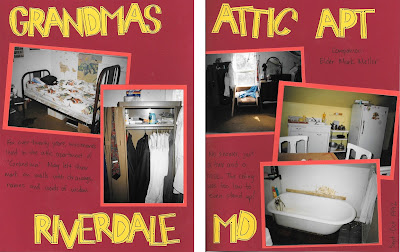Well, take a gander at this youtube video my friend Steph Clay from Modern Photo Solutions made! There is a way to go straight from Google Photos to the PL app! Huzzah!
So, you'll have to try it out for yourself and see what you think. Personally it has been a little hit and miss for me, usually I can pull in the first photo, but it has trouble on any photos after that. I'll keep trying it though.
Anyway....now for the paper to digital page conversion this post is all about...
This one is a little bit different from the others I've shared so far, in that I'm going to use another app besides the PL app to add my journaling. You'll see why if you keep reading.
Firstly, here's the page I'm starting with:
Once again I had no journaling. But look at that piece of "Currency of the World" stationery I used as a background. If that doesn't scream late 1990s scrapbooking, I don't know what does! *Insert eye rolling emoji here* But I had some cute pictures, and that's what the page is mostly about, right?
So, I had this whole page scanned and saved into Google Photos, so I used the method in the video above and pulled the whole page into one of the large slots in the Big Shot 23 template.
It was at this point that I knew there was no getting around that stationery that was going to show in the background. I had cut my photos too skinny, and if I tried to zoom in on the cutie in the pictures, by the time I "cropped" out the stationary, you couldn't see the outfit. So I decided to keep the photos as big as possible, and deal with the patterned paper.
I had those two empty card spots that I wanted to use for journaling, so I had the fantastic (if I do say so myself) idea of bringing in that patterned paper into those slots. So I went back to the original page and pulled a "blank" portion of the patterned paper into each of those slots.
 |
| I tried to use different parts of the patterned paper, so it wouldn't just look like the same "money" in both slots. |
I liked the cadet blue coloring that I had matted my photos with originally, so I search through some of the PL app kits until I found one that matched pretty well (Baby Boy Edition), and added that as my page background.
Now, having done that I had pretty much made it impossible to add journaling via the PL app. I saved an editable backup copy of the page at this point so if I ever wanted to, I could come back to this version and remove the patterned paper slots and put in a PL journaling card (you know, in case a super cute new set gets released next week or something!)
But, having put those "photos" in the journaling slots, I can't add journaling with the PL app, so I'd have to go outside of the app to do it.
So I exported my page as a 12x12 and saved it to my phone's camera roll. Then I opened up the LetterGlow app (free version) and used it to add my journaling. (All I've learned to do in the LetterGlow app is from watching YouTube videos.)
 |
| This is what the app icon looks like if you searching in the App Store. |
I opened the LetterGlow app and pulled in my picture from my camera roll, and added the text. I picked a size and font and color and then positioned it on the page (YouTube tutorials can show you all of this if you're interested--no use reinventing the wheel showing you here-plus I don't know how to make videos and I don't want to have you have to hear my voice on video! Ha!)
Once I had added my journaling, I saved the finished page onto my camera roll and then backed it up on Dropbox. So in total I had an editable backup of the page with the blue background and patterned paper in the journaling slots, a whole page image saved 12x12 of the page without any journaling, and then another saved 12x12 whole page image of the finished product:
Let me know in the comments which camp you fall into. PL app only, or sometimes combined with other apps. If so, what are your favorite other apps to use. I've tried LetterGlow and Over (similar functionality) but prefer LetterGlow.
Until next time....



















































